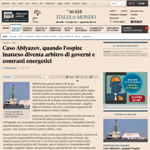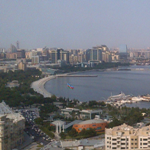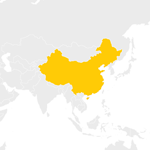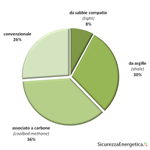 A volte perfino sul Sole 24 Ore si trovano pezzi dai contenuti dubbi, come quello di oggi sul caso Ablyazov e sui rapporti tra l’Italia e il Kazakhstan. Al netto della questione dell’estradizione, il pezzo si chiude con un esempio di fantapolitica energetica condita da un candido disinteresse per i fatti. Introdotto da un accenno di sospetto.
A volte perfino sul Sole 24 Ore si trovano pezzi dai contenuti dubbi, come quello di oggi sul caso Ablyazov e sui rapporti tra l’Italia e il Kazakhstan. Al netto della questione dell’estradizione, il pezzo si chiude con un esempio di fantapolitica energetica condita da un candido disinteresse per i fatti. Introdotto da un accenno di sospetto.
Citando direttamente gli ultimi due capoversi:
Ultima considerazione, solo un indizio. Nell’ultimo Consiglio europeo di fine giugno, il premier Enrico Letta si è presentato in conferenza stampa sorridente per i risultati del vertice sull’occupazione. A un certo punto, Letta ha srotolato davanti ai giornalisti una mappa del nuovo gasdotto transadriatico Tap che consentirà l’afflusso del gas del Caspio dall’Azerbajan in Italia via Albania e Grecia tagliando fuori la Russia.
L’Italia vorrebbe parteciparvi. Così come voleva stare nel Bleu Stream insieme a Putin ed Erdogan e nel Nabucco a firma senza Putin). Ma il problema è che si tratta di progetti alternativi uno all’altro con impegni geostrategici diversi, spesso contraddittori. Sotto questo profilo il “pasticciaccio kazako” potrebbe anche essere un messaggio russo – via Astana – al nuovo giovane leader italiano per ricordargli, ove se lo fosse dimenticato, quanto permeabile e fragile sia tutto il nostro sistema.
Da dove cominciare? Dunque, l’Italia del TAP è il punto di arrivo: più partecipazione di così non si può. Se poi per Italia si intende Enel, forse è ora di rivedere qualche categoria analitica.
Andiamo avanti: Bleu Stream non esiste. E nel Blue Stream, il gasdotto che va dalla Russia alla Turchia, l’Italia non c’è. Ma Eni c’è, eccome: è socio al 50% con Gazprom.
Per quanto riguarda il Nabucco, il governo italiano non ha mai partecipato, così come non erano coinvolte aziende italiane.
Resta poi un mistero in che modo sarebbero alternativi un gasdotto in fase di costruzione da 10 miliardi di metri cubi (Gmc) che porterà nel 2020 gas azerbaigiano in Italia (TAP), un gasdotto già operativo da un decennio e che porta 16 Gmc all’anno di gas russo dedicato al mercato turco (Blue Stream) e un gasdotto abortito che avrebbe dovuto portare gas mediorientale in Austria.
Forse l’autore aveva in mente South Stream, il progetto russo-italiano-francese-tedesco da 60 Gmc, ma non è dato saperlo. Di certo evocare non meglio definite questioni “geostrategiche” proprio in chiusura non aiuta la comprensione. Meglio però chiarirsi le idee, prima di confonderle ai lettori.
 Segnalo un contributo di Valerio Abbagnara (Enel) dal titolo General overview on the essential elements of the European states’ energy security policy.
Segnalo un contributo di Valerio Abbagnara (Enel) dal titolo General overview on the essential elements of the European states’ energy security policy.





 La vittoria del
La vittoria del 



